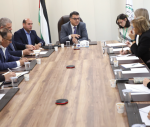You are here
Sustainable health solutions for refugees in low- and middle-income countries
Jun 27,2024 - Last updated at Jun 27,2024
World Refugee Day is an annual occasion that is marked in 2024 with a call for more solidarity with individuals who are forced to flee for their lives. As the situation of those who are forcibly displaced is becoming increasingly dire, demonstrating solidarity is more critical than ever.
In recent years, the number of refugees and internally displaced persons (IDPs) has risen to concerning levels. In the Eastern Mediterranean Region, an area stretching from Morocco to Afghanistan, millions of people have fled their home cities and countries in search of safety, escaping conflict, economic hardships, environmental disasters, among other threats. Numbers from the United Nations High Commissioner for Refugees (UNHCR), the International Organisation for Migration (IOM), and other relevant entities show a significant increase in refugees crossing international borders and IDPs seeking protection outside their residences while remaining within national borders.
The UNHCR reveals regionally pertinent numbers: low-to-middle-income (LMIC) countries host 75 per cent of the world refugees, 39 per cent of whom are hosted in five countries, three of which are in the EMR and neighbouring regions: Iran (3.8 million), Pakistan (2.0 million) and Turkey (3.3 million). Internal displacement is also a growing concern in the EMR. Almost all IDPs (99.5 per cent) live in LMICs, many of which are countries within EMR borders. Sudan is home to the world’s worst current IDP crises, which according to the IOM houses 9.0 million IDPs. In Gaza, 1.7 million people are crammed inside an area of 365 km2 where they have been displaced once, twice and thrice. A similar situation is observed in Yemen, where 4,516,341 people make up the IDP population in the country.
Beyond numbers and figures, these refugees and IDPs encounter significant health challenges. The 2023 WHO’s World Report on the Health of Refugees and Migrants documents health threats, risks and vulnerabilities, albeit differential across regions and countries. These include increased occupational health hazards, unmet sexual and reproductive health needs, poor access to Maternal and Child Health services, increased risk of non-communicable diseases (NCDs), mental health issues and propensity to infectious diseases. According to the first analysis of peer-reviewed research on health-related studies in IDP populations globally, IDPs fare worse because they lack official legal status given to refugees and do not receive the corresponding legal protections from specialised organisations such as IOM and UNHCR. Some of the of health issues documented in the afore-cited study were as follows: increased risk of infectious diseases, including vector borne diseases and vaccine preventable diseases, higher prevalence and mortality from NCDs, and higher levels of post-traumatic stress disorder, depression and anxiety.
In response to these alarming figures, the global health community is renewing its commitment to swifter action for refugee health. This is evidenced in the Third Global Consultation on the Health of Refugees where the Rabat Declaration was adopted to formulate, implement, and expand policies supporting the health of refugees and migrants. Similar commitment is shown by international, regional and local humanitarian organisations working in line with the Guiding Principles on Internal Displacement in support governments hosting IDPs.
But how can such global recognition be translated into tangible action? And is the work already being done sufficient?
I will answer these questions by presenting key points based on over a decade of experience working primarily in war and conflict zones where these populations reside, living in a country hosting refugees in the EMR, and collaborating closely with ministries of health and international organisations to address immediate health need of these populations.
Refugees and IDPs are often found in LMICs. There, refugee influxes and internal displacement burden host and national health systems as more people demand health services and as additional health problems arise from population increase and/or movement. Often, the response to such situations is donor aid, which typically delivers short-term interventions to issues with long-term effects. Instead, what is truly needed are sustainable solutions that address the issues at the core. To achieve this, focus must shift to health systems strengthening (HSS) in these LMICs and others likely to experience the same challenges. More specifically, a country-tailored HSS approach should be developed, one that integrates refugee and IDP health within all HSS components. This is the most effective, sustainable strategy that will build health systems ready to deal with the challenges of displacement, while remaining resilient and well-functioning to serve all population needs.
However, HSS strengthening requires substantial assistance, which logically entails securing adequate funding. The critical role of financial assistance cannot be overstated: it enables refugee inclusion, integrated information systems, expanded service delivery and a competent health workforce.












Add new comment